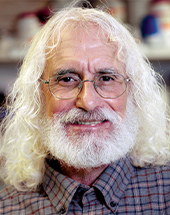AACR President's Vision: Envisaging the Future of Cancer Research and Patient Care

Philip D. Greenberg, MD, FAACR
AACR President 2023-2024
Professor & Head, Program in Immunology The Rona Jaffe Foundation Endowed Chair
Investigator, Parker Institute for Cancer Immunotherapy
Fred Hutchinson Cancer Center
Seattle, Washington
The progress in cancer research has been breathtaking, as has been documented in the AACR Cancer Progress Report 2023, and the 12 prior editions. When I started in the field of cancer medicine, cancers were treated with a sledgehammer approach, where chemotherapy and radiation therapy with limited selectivity for cancer cells were used. That has evolved remarkably in the last two decades into an era of precision oncology where individual patients are treated based on the characteristics of their own cancer. This evolution of cancer science and medicine in large part has taken place in four research areas.
The first area is cancer genomics and epigenomics. The revolution in this area was enabled at the turn of the millennium by advances in nucleic acid sequencing technologies and the mapping of the human genome. The latter was largely funded by NIH, and without such support, we wouldn’t be where we are now with respect to our understanding of cancer at a cellular and molecular level. We can now readily and rapidly sequence a patient’s cancer cells and understand precisely how they are different from normal cells. This helps identify specific abnormalities that can be targeted and that are selective for that patient’s tumor.
The second area is synthetic chemistry, which has changed the way we target abnormalities in a tumor. Using synthetic chemistry, we can create and then modify large numbers of compounds and make them increasingly selective against cancer cells. Thus, synthetic chemistry is transforming the way we can design molecularly targeted therapeutics.
The third area, and focus of my own research, is immunotherapy. We’ve gone from skepticism about the role of the immune system in defending against cancer to the discovery of immune checkpoint blockade to the development and approval of many immune checkpoint inhibitors that are already helping patients with cancer live longer and fuller lives. The exciting new areas include the ability to engineer immune cells to target cancer precisely using adoptive cell therapy and the ability to produce therapeutic vaccines that will induce immune responses specifically against cancer.
The fourth area is computational biology, data science, and artificial intelligence, all of which are changing the ways we analyze and interpret data and use that information to drive new discoveries.
As we envision and advance the frontiers of cancer science and medicine, the idea of bringing two proteins together that normally don’t interact, and making their interaction change the biology of the cell in a way that can be used for developing new anticancer therapeutics, is rapidly evolving. Advances in single cell technologies— which enable analysis of specific cell populations in a tumor to identify which genes are active in individual cells—are providing the basis for strategies that can target tumors more effectively. Similarly, liquid biopsy is another remarkably sensitive technology that has the potential to change the future landscape of cancer medicine, and I believe it will play an enormous role in the future in cancer prevention and early detection. These advances are moving rapidly from the laboratory to the clinic, and they’re going to change the way cancer is prevented, detected, treated, and monitored, so we can continue to improve the quality of life for more patients with cancer.
Despite the progress we have made against cancer, it is important to recognize that much work still needs to be done in key areas. There is an enormous problem of disparities in access to health care and delivery of health care that disproportionately affects socioeconomically disadvantaged groups. Addressing these disparities would greatly decrease the number of cancer deaths in the U.S. Another challenge is the low participation of patients with cancer in clinical trials. Only about 6 percent of patients with cancer enroll in clinical trials for treatment. We need to communicate better the benefits of participating in clinical trials if we are to deliver on the potential of new therapeutics.
Nearly all advances in cancer research and cancer therapies have evolved from studies in basic science. The report provides enormous optimism and communicates to the public and policymakers the advances that have been delivered to patients with cancer and how they are transforming patients’ lives. It also offers an insight into the problems that we are in the process of addressing.
We are in a time of unparalleled opportunities in cancer research. Not increasing investment in cancer research will impede the momentum against cancer. A substantial decrease in dollars for research that is on the table at Congress right now will also result in the loss of an incredibly talented and creative young workforce that is infusing new ideas and new technologies in cancer research. The perception that we can cut back on funding for cancer research without much impact is unrealistic and unacceptable.
There is no reason why cancer death rates can’t continue to decline. But it will take commitment by cancer researchers, the government and the cancer community to invest in cancer research, and to increase patients’ involvement in cancer trials. These strategies will improve the quality and survival of patients with cancer and realize the President’s Cancer Moonshot goal of ending cancer as we know it.
Envisioning the Future of Cancer Science and Medicine